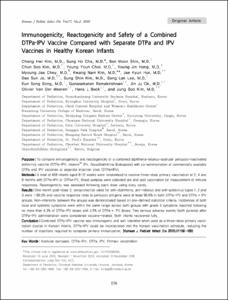Immunogenicity, Reactogenicity and Safety of a Combined DTPa-IPV Vaccine Compared with Separate DTPa and IPV Vaccines in Healthy Korean Infants
- Keimyung Author(s)
- Kim, Chun Soo; Lee, Sang Lak
- Department
- Dept. of Pediatrics (소아청소년학)
- Journal Title
- 소아감염
- Issued Date
- 2010
- Volume
- 17
- Issue
- 2
- Keyword
- Acellular pertussis; DTPa-IPV; DTPa; IPV; Primary vaccination
- Abstract
- Purpose : To compare immunogenicity and reactogenicity of a combined diphtheria-tetanus-acellular pertussis-inactivated poliovirus vaccine (DTPa-IPV, $Infanrix^{TM}$ IPV, GlaxoSmithKline Biologicals) with co-administration of commercially available DTPa and IPV vaccines at separate injection sites (DTPa+IPV). Methods : A total of 458 infants aged 8-12 weeks were randomized to receive three-ose primary vaccination at 2, 4 and 6 months with DTPa-IPV or DTPa+IPV. Blood samples were collected pre and post vaccination for measurement of immune responses. Reactogenicity was assessed following each dose using diary cards. Results : One month post-dose 3, seroprotection rates for anti-diphtheria, anti-tetanus and anti-poliovirus types 1, 2 and 3 were ${\geq}99.5%$ and vaccine response rates to pertussis antigens were at least 98.6% in both DTPa-IPV and DTPa + IPV groups. Non-inferiority between the groups was demonstrated based on pre-defined statistical criteria. Incidences of both local and systemic symptoms were within the same range across both groups with grade 3 symptoms reported following no more than 4.3% of DTPa-IPV doses and 4.5% of DTPa + IPV doses. Two serious adverse events (both pyrexia) after DTPa-IPV administration were considered vaccine-related. Both infants recovered fully. Conclusion : Combined DTPa-IPV vaccine was immunogenic and well tolerated when used as a three-dose primary vaccination course in Korean infants. DTPa-IPV could be incorporated into the Korean vaccination schedule, reducing the number of injections required to complete primary immunization.
목적 : 디프테리아, 파상풍, 백일해 및 불활화 폴리오 백신인 GlaxoSmithKline Biologicals의 $Infanrix^{TM}$-IPV(DTPa-IPV)를 접종시, 시판되고 있는 DTPa 백신과 IPV 백신을 각각 다른 부위에 동시 접종 했을 때(DTPa+IPV)와의 면역원성과 반응원성을 비교하기 위하여 본 연구를 시행하였다. 방법 : 생후 8-12주의 영아 458명을 무작위 배정하여, 각각 2, 4, 6개월에 DTPa-IPV 혹은 DTPa+IPV를 3회 기초접종 하였다. 면역반응을 확인하기 위하여 백신접종 전과 후에 채혈을 하였다. 반응원성은 각 백신 접종 후 작성된 증상기록카드를 통하여 평가하였다. 결과 : 3차 백신접종 한달 후에, 항-디프테리아, 항-파상풍 그리고 항-폴리오바이러스 type 1, 2, 3에 대한 혈청 방어율(seroprotection rate)은 ${\geq}99.5%$였고, 두군 모두 백일해 항원에 대한 백신 반응률(vaccine res-ponse rates)은 적어도 98.6% 이상이었다. 두 군간의 비 열등성은 사전 정의된 통계적 기준에 따라 보여주었다. 국소증상과 전신증상 발생률은 두 군 모두 비슷하게 보고되었고, grade 3의 증상이 DTPa-IPV 투여군에서 4.3%, DTPa+IPV 투여군에서는 4.5%로 보고되었다. 두 건의 중대한 이상반응(모두 발열)이 DTPa-IPV 투여 후에 보고되었고, 백신과의 연관성이 있는 것으로 간주되었다. 두 명의 영아는 모두 회복되었다. 결론 : DTPa-IPV 혼합백신은 한국의 소아들에게 기초접종으로 3회 투여시 충분한 면역반응을 보였고, 내약성이 우수했다. DTPa-IPV는 한국 예방접종 스케줄에 편입되어, 기초 접종을 완료하기 위한 접종 회수를 줄일 수 있다.
- Alternative Title
- 한국의 건강한 영아를 대상으로 DTPa-IPV 혼합백신을 접종한 경우와 DTPa 백신과 IPV 백신을 각각 투여하 였을 경우의 면역원성, 반응원성 및 안전성
- Publisher
- School of Medicine
- Citation
- Chang Hwi Kim et al. (2010). Immunogenicity, Reactogenicity and Safety of a Combined DTPa-IPV Vaccine Compared with Separate DTPa and IPV Vaccines in Healthy Korean Infants. 소아감염, 17(2), 156–168.
- Type
- Article
- ISSN
- 1226-3923
- Appears in Collections:
- 1. School of Medicine (의과대학) > Dept. of Pediatrics (소아청소년학)
- 파일 목록
-
-
Download
 oak-bbb-4518.pdf
기타 데이터 / 453.26 kB / Adobe PDF
oak-bbb-4518.pdf
기타 데이터 / 453.26 kB / Adobe PDF
-
Items in Repository are protected by copyright, with all rights reserved, unless otherwise indicated.